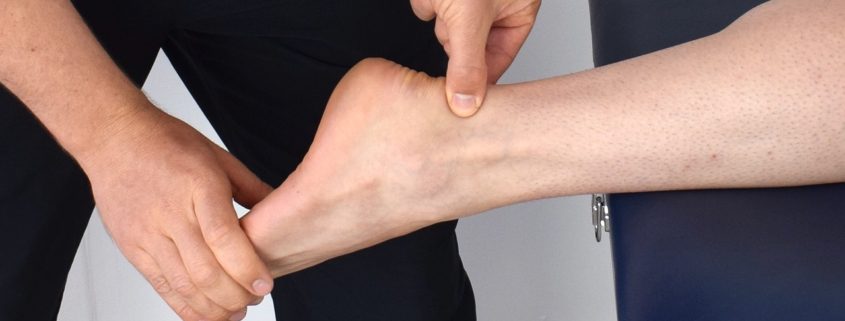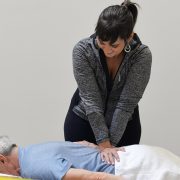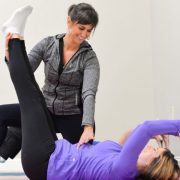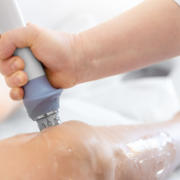Best Treatments for Persistent Plantar Fasciitis – According to Science
Ever had nagging foot and heel pain that’s so bad it feels like you’re walking around on glass? Yep – that’s called plantar fasciitis – and it impacts over 2 million individuals in the United States every year.
Plantar fasciitis occurs when you have inflammation of your plantar fascia – the tissue that makes up the arch (bottom) of your foot.
Your plantar fascia is responsible for both the mobility and stability of your foot so that you can propel yourself during walking and running. When you suffer from plantar fasciitis – it’s not only annoying and painful – but can be quite debilitating. It keeps runners from running, walkers from walking, and eventually will cause problems up the kinetic chain (think knees and hips) when left untreated. Typical treatments for plantar fasciitis include everything from rest, ice, cortisone shots, orthotics, braces, exercise, and stretching.
But which treatments are best?
Depending on who you ask – you’ll get a lot of different answers – so let’s see what the science and research says.
Cortisone Shots:
While there is plenty of evidence to support the use of cortisone shots for reducing pain and inflammation – it’s important to consider the consequences of how cortisone works. When you’ve got damaged, painful tissue from overuse or overstretching – such as what can occur with plantar fasciitis. The cells in your tissue respond by releasing certain factors designed to recruit blood vessels, stem cells, and healing factors. The inrush of these fluids causes temporary swelling and pain, but it also stimulates the laying down of new collagen. Collagen, a naturally occurring protein in your body that helps tissue to heal and become strong again. Cortisone works by shutting down this cellular process. Which is great because it stops the swelling and pain from occurring. But by doing so – it inhibits your body’s natural healing process.
This can result in weakened tissue that stays in a weakened state. Leaving you susceptible to repeated and sometimes permanent damage over time, especially if you keep getting cortisone shots. So while cortisone injections may appear to be the miracle quick-fix you’re looking for – it’s crucial you consider the long-term consequences that inhibited tissue healing could cause.
Extracorporeal Shockwave Therapy:
Unlike cortisone shots, this therapy aids in the tissue-healing process instead of inhibiting it. And there is good research and evidence to support its use with plantar fasciitis specifically. While it’s been successfully used in Europe for decades, it didn’t surface in the United States until around the year 2000. Shockwave Therapy uses acoustic sound waves to stimulate the same natural healing process described above. This can be especially useful in tissue that has already experienced damage. What I like about Shockwave Therapy – is that it’s completely non-invasive – compared to something like platelet-rich plasma (PRP) injections (another popular treatment for plantar fasciitis). With injections, there is always a risk of infection. You don’t have to worry about that with Shockwave Therapy. That, combined with promising evidence for significant pain reduction in as few as six sessions, makes this a wise treatment choice for plantar fasciitis.
Stretching and Strengthening Exercises:
For most musculoskeletal injuries (plantar fasciitis included) the research overwhelmingly supports the use of stretching and strengthening as an effective and long-lasting means of treatment. So why does this approach fail so often? And make us quick to resort to injections, surgery and other types of medical procedures to resolve musculoskeletal-related pain? The biggest problem I see is not with the stretches and exercises themselves, but with exercise prescription. That’s why you can’t just go to Google or YouTube and look for “the best exercises for plantar fasciitis”. Finding great and appropriate exercises isn’t the issue.
The problem is that you won’t know when and how to perform them – and you risk making your plantar fasciitis worse or resorting too quickly to a more invasive treatment option because you think the exercises just didn’t work. With plantar fasciitis specifically, the type of stretching and exercise you choose has to match the stage of tissue healing. You have to load the tissue just enough to cause the appropriate amount of tissue damage that will elicit remodeling of tissue fibers – but not so much that you elicit an inflammatory cycle, which will disrupt the remodeling process. The only way plantar fasciitis truly heals is through remodeling the damaged tissue. And this requires a perfectly prescribed stretching and exercise protocol – which can take up to 7-9 months to work.
So be cautious of the quick fixes, work with an expert, and be patient in this process – because stretching and strengthening really do work when done correctly for Plantar Fasciitis.
In the battle against plantar fasciitis, a prescribed combination of stretching and strengthening exercises, along with non-invasive passive modalities that work to enhance your body’s natural healing process tend to be the most effective. Stay away from ice, rest, and other invasive procedures that disrupt healing or interfere with tissue remodeling. If your plantar fasciitis is chronic, understand that there’s still hope, but it may take some time. My advice is to talk with an expert who is up to date on the latest research, and who has a good understanding of tissue healing and remodeling.
Because ultimately – the best treatment for plantar fasciitis must involve a combination of these two things.
Dr. Carrie Jose, Physical Therapist and Pilates expert, owns CJ Physical Therapy & Pilates in Portsmouth and writes for Seacoast Media group. To get in touch, or to inquire further about Shockwave Treatment, visit her website www.cjphysicaltherapy.com or call 603-605-0402










